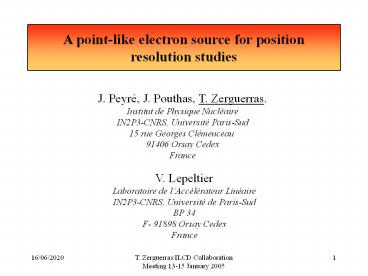A point-like electron source for position resolution studies - PowerPoint PPT Presentation
Title:
A point-like electron source for position resolution studies
Description:
A point-like electron source for position resolution studies. J. Peyr , J. ... expander #1. Beam. expander #2. Focalisation. triplet. Beam. profile. 10/7/09 ... – PowerPoint PPT presentation
Number of Views:12
Avg rating:3.0/5.0
Title: A point-like electron source for position resolution studies
1
A point-like electron source for position
resolution studies
J. Peyré, J. Pouthas, T. Zerguerras. Institut de
Physique Nucléaire IN2P3-CNRS, Université
Paris-Sud 15 rue Georges Clémenceau 91406 Orsay
Cedex France
V. Lepeltier Laboratoire de lAccélérateur
Linéaire IN2P3-CNRS, Université de Paris-Sud BP
34 F- 91898 Orsay Cedex France
2
Motivations
55Fe source (g 5.9keV) Advantage
Well known number of primary electrons (about 200
in
all gases). Inconvenience Random
photon interaction position. X ray tube
Advantage Photon interaction point
localized. Inconvenience
Impossible to vary the number of primary
electrons.
3
Experimental set up with a MICROMEGAS
Anode (128 strips Width 323µ Pitch 338µ)
Mesh (500lpi)
Beam expander 1
Beam expander 2
Focalisation triplet
Laser N2 (337nm)
Beam profile
Drift electrode
Drift gap 2,8mm Amplification Gap 125µm Gas
Ne 90 iC4H10 10
4
Y
X
Z
5
Micromegas gain
Measurements with a 55Fe source
Grid (V)
6
Micromegas typical signals
Grid
Strips
Ne 90 Isobutane 10 Laser 337nm Vd1480V Vg500V
About 700 primary e-
7
Charge distribution on strips
About 3600 primary e-
8
Position reconstruction
Event by event gaussian fit
Charge
Strip position
Real position deduced by using a calibration
function
smes ssource Å sdiff Å sother
9
Real position reconstruction
Ne 90 Isobutane 10
10
Distribution s
Ne 90 Isobutane 10
MAGBOLTZ Dt 360µ/cm1/2
Upper Limit ssource lt 80µm
11
Conclusions
- Advantages of using a UV laser
- point-like e- source.
- variation of the number of primary e- in a huge
range.
Preliminary results look promising
Other measurements and data analysis are under
progress Measurements with a MICROMEGAS
resistive foil (Collaboration with CEA-DAPNIA
Saclay).































